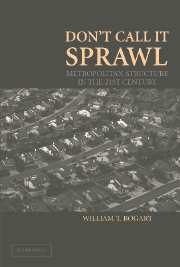Book contents
- Frontmatter
- Contents
- Acknowledgments
- 1 The World of Today
- 2 Making Things Better: The Importance of Flexibility
- 3 Are We There Yet?
- 4 Trading Places
- 5 Downtown: A Place to Work, a Place to Visit, a Place to Live
- 6 How Zoning Matters
- 7 Love the Density, Hate the Congestion
- 8 Homogeneity and Heterogeneity in Local Government
- 9 The World of Tomorrow
- Notes
- References
- Index
5 - Downtown: A Place to Work, a Place to Visit, a Place to Live
Published online by Cambridge University Press: 02 December 2009
- Frontmatter
- Contents
- Acknowledgments
- 1 The World of Today
- 2 Making Things Better: The Importance of Flexibility
- 3 Are We There Yet?
- 4 Trading Places
- 5 Downtown: A Place to Work, a Place to Visit, a Place to Live
- 6 How Zoning Matters
- 7 Love the Density, Hate the Congestion
- 8 Homogeneity and Heterogeneity in Local Government
- 9 The World of Tomorrow
- Notes
- References
- Index
Summary
The functions that continue to gather in what may be called central districts or hubs of the urban nebulae are offices, laboratories, and all the activities related to the various forms of entertainment. As in Roman times, the arena and the forum, in their modern versions, occupy an increasing share of the hubs. Entertainment and offices are related one to another, thriving on proximity. They create a large market for white-collar labor. All these trends started at an earlier time and they have already developed on a great scale in Megalopolis. The forces bringing about this evolution are rooted in a deep transformation of modern modes of life and habitat.
Jean Gottman (1961, 776–7)It is commonly believed that the effect of new transportation infrastructure, such as the interstate highway system, is to suck residents and jobs out of central cities and downtowns. While the decentralization of jobs and residents has been well documented, the logic in this argument about highways is incomplete. The impact of any new transportation (or communications) system should be to increase movement in both directions between the points that it connects and therefore to encourage trade between those points. With greater trade should come greater specialization in the production of the goods and services that each location in the metropolitan area does best.
To stretch the trade analogy further: the interstate highway system is similar to the development of large, fast ocean-going vessels that permitted Britain to specialize in textile production at the start of the Industrial Revolution, trading manufactured goods for grain and timber from America.
- Type
- Chapter
- Information
- Don't Call It SprawlMetropolitan Structure in the 21st Century, pp. 89 - 117Publisher: Cambridge University PressPrint publication year: 2006



